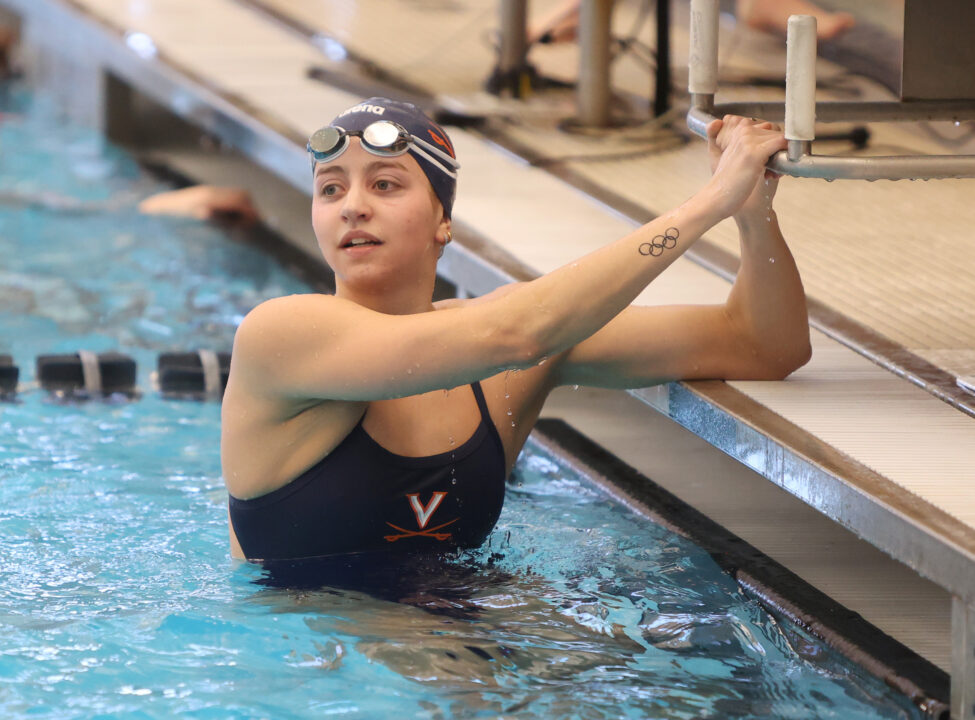The pre-selection entry lists for the 2022 Women’s NCAA Division I Swimming & Diving Championships have been published. The meet will run from March 16-20 in Atlanta at the Georgia Tech Mcauley Aquatic Center.
These pre-selection lists don’t show who will qualify, but do give some clues as to what races athletes will swim at the upcoming NCAA Championship meet.
SwimSwam will calculate where the projected cut line should be based on these sheets this morning.
The official list of qualifiers, and an alternates list, will be published on Wednesday.
Throughout the day, SwimSwam will breakdown some of the more interest selection lists, including:
- Torri Huske, Stanford – 200 IM, 100 fly, 100 free
- Brooke Forde, Stanford – 400 IM, 200 breast, 500 free
- Regan Smith, Stanford – 100 back, 200 back, 200 fly
- Alex Walsh, Virgiina – 200 IM, 400 IM, 200 fly
- Kate Douglass, Virginia – 50 free, 100 fly, 200 breast
- Katharine Berkoff, NC State – 50 free, 100 back, 100 free
- Ellen Walshe, Tennessee – 200 IM, 400 IM, 100 fly
- Lia Thomas, Penn – 100, 200, 500 free
INDIVIDUAL QUALIFIERS
The NCAA invites the same number of overall swimmers every year. 270 men and 322 women make the meet every year. Depending on how many of those 270/322 athletes qualify in multiple events, the numbers can range some as to how many entries in each event get invited. Last year, the first year under this selection system, roughly 29 men and 38 women were invited in each event.
The simple part: “A” qualifiers get in automatically. Hit an “A” cut, and you’re set. Then the NCAA fills in the remaining spots with the next-fastest “B” cuts.
Here’s a step-by-step process for how the NCAA selects the 270 men and 322 women for each year’s invite list:
1. 35 of the men’s spots and 41 of the women’s spots are set aside for divers, who qualify for the meet at zone competitions closer the NCAA Championships. That leaves 235 men’s spots and 281 for the women.
2. Every “A” cut put up this season is added.
3. The next fastest swimmers in each event are added until every event has the same number of entries. For example, if the 50 free were to have the most “A” cuts of any event with 10, then every other event would get swimmers with the top 10 fastest times in.
4. Finally, one entry is added to each event to keep the entries per event even. This process is repeated until all of the swimming spots (235 for men, 281 for women) are filled. Keep in mind that as more rows are added, swimmers will start to double and triple up. The #1 seed in the 200 back might be the #15 seed in the 100 back – as the 15th row of swimmers is added to each event, she’ll be added to the 100 back list, but won’t take up another one of the 281 invite spots, as she already has her official invite.
5. The final row of swimmers added won’t come out exactly even. In the final row, the swimmers with entry times closest to the NCAA “A” cut will get added first, and when the 235th man or 281st woman is added, the process stops. So the 100 fly could have 38 women and the 200 fly 39 women – that would mean the 39th 200 flyer was closer to the NCAA “A” than the 39th 100 flyer and therefore won the ‘tie-breaker’ for the final spot.

Super helpful explanation of the process. Thank you.
Can’t wait for cal to exceed expectations! Go bears!
Scored out top 10 teams
1 Virginia-VA 479
2 Stanford-PC 355.5
3 NC State-NC 304
4 Tennessee-SE 288.5
5 Alabama-SE 256
6 Texas-ST 232.5
7 Ohio St-OH 226.5
8 Michigan-MI 198
9 California-PC 184
10 Southern Cali-CA 137
Doesn’t include diving, but does take ties into account.
Aaand all that work in excel for them to post an article like 3 minutes later.
The 200 IM and 400 IM races are going to be epic.
Sub 2:00 on Desorbo’s watch.
My Free Predictions:
50 Free
100 Free
200 Free
500 Free
1650 Free
How do relay invites work?
Once a team has an “A” cut in a relay, they can swim all relays in which they have a “B” cut (formally termed Qualifying Standard and Provisional Standard). Teams need an individual qualifier to make it.
Or if they have 4 individual qualifiers, they can swim any relays in which they have a “B” cut. That doesn’t often happen.
thank you! How do the relay swimmers factor into the total number of swimmers and priority of invite?
100 fly 50 free and 400IM are gonna be so nuts